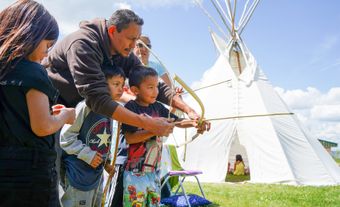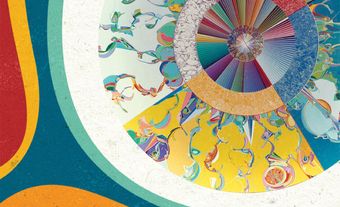Settlement and Development
Red Deer is located on the traditional territory of the Siksikaitsitapi (Blackfoot Confederacy), Tsuut’ina, Stoney Nakoda, Cree, Saulteaux and Métis peoples. The area is covered by two treaties. Treaty 6, signed in 1876, and Treaty 7, signed in 1877.
The first European settlement began in 1882 where the old Calgary-Edmonton Trail crossed the Red Deer River. During the North-West Resistance (1885) the Canadian militia constructed Fort Normandeau at this site. The post was then used by the North-West Mounted Police until 1893. In 1891, the settlement moved 7 km downstream to a site on the newly constructed Calgary-Edmonton Railway (later part of the Canadian Pacific Railway). Around the turn of the century, the community experienced a surge of growth as a huge number of settlers flooded into the area to take up homesteads.
Red Deer developed primarily as an agricultural service and distribution centre. These activities were enhanced by its location midway between Calgary and Edmonton, in the centre of a very fertile mixed-farming district. It became a major divisional point of the CPR in 1907, and in 1911 the Alberta Central and Canadian Northern railways entered the town.
Michener Centre and Eugenics
In 1923, the Provincial Training School for Mental Defectives opened in Red Deer. The school was later renamed the Michener Centre. It was meant to house and train those with developmental disabilities; however, the institution’s population also included children without developmental disabilities. For example, immigrant children were over-represented at the institution. In 1928, Alberta passed the Sexual Sterilization Act. The Act established a Eugenics Board with the power to authorize the sexual sterilization of certain individuals (seeEugenics in Canada). During the 44 years in which the legislation was in effect, the Eugenics Board approved 4,725 cases for sterilization, of which 2,834 were carried out. Many of the individuals who were sterilized were residents of the Michener Centre, which acted as a feeder institution for the Eugenics Board.
Oil and Gas Industry
After the Second World War, with the discovery of significant oil and natural gas fields in the area, Red Deer entered a prolonged boom. In the late 1950s it was one of the fastest-growing cities in Canada. The petroleum service industry became an increasingly important part of Red Deer’s economy. After a lull in growth in the early 1970s, another boom accompanied the construction of petrochemical plants east of the city in the hamlets of Joffre and Prentiss. The oil and natural gas industry continues to play a major role in Red Deer’s economy.
Cultural Life
Red Deer is home to Red Deer College, a large regional health-care centre, and extensive convention and exhibition facilities. Attractions include St. Mary's Church (1968), Red Deer Museum and Art Gallery (1973), Fort Normandeau Interpretive Centre (1985), Kerry Wood Nature Centre (1986) and Alberta Sports Hall of Fame (1996).

 Share on Facebook
Share on Facebook Share on X
Share on X Share by Email
Share by Email Share on Google Classroom
Share on Google Classroom



